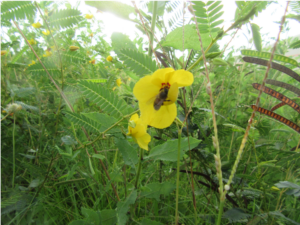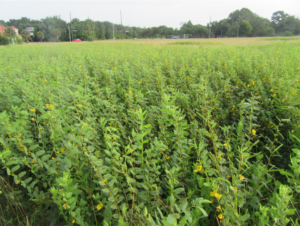Partridge Pea: A Cover Crop for Hot and Humid Areas
SUBTROPICAL SOIL HEALTH TIPSHEET SERIES
By Justin Duncan, NCAT Agriculture Specialist
From 2017 to 2021, NCAT’s Subtropical Soil Health Initiative tested velvet bean as a cover crop in the subtropical Rio Grande Valley of South Texas. This tipsheet was developed in part from the findings of those field trials.
Introduction
Most Cassia, also known as Chamaecrista, are small trees, but there are a couple species that lend themselves to use as cover crops. The first is C. rontundifolia, or round-leaf Cassia, which has a prostrate growth habit and grows about a meter wide. It’s native to the Americas and distributed from Mexico and the Caribbean in the north to Argentina in the south. The other species is C. fasciculata, or partridge pea, which has an upright growth habit. It is native to Texas, the southeastern United States, and Mexico. Partridge pea is relatively untouched by disease and suffers from few pests. It can be seen blooming in pastures until frost.

A honey bee visits this partridge pea flower, collecting pollen and nectar for its hive. Photo: Justin Duncan, NCAT
Partridge pea is adaptable to areas where there is adequate drainage, as well as moisture. In other words, it appreciates sandy soils. It also does well on the depleted red clay soils of southern China. These soils are low in macronutrients, micronutrients, and trace elements, as well as high in aluminum, but, nonetheless, round-leaf Cassia is productive (Hacker et al., 1997). These red clay soils are somewhat similar to those found throughout the humid southern United States.
Cassia should not be grazed by cattle while it is in later stages of growth, i.e., after flowering, due to toxicity issues. It is not recommended for horses. The root was once traditionally used in Native American medicine as a stimulant and to increase stamina (Hamel and Chiltoskey, 1975).
Soil Nutrients
As a cover, Cassia is effective at reclaiming surface-mined areas due to its excellent pioneering potential. Mined areas are low in fertility, organic matter, macronutrients, and micronutrients, and especially soil flora and fauna and microorganisms. Cassia can flourish in these conditions and initiate the reclamation process (Gillman, 2014). It fixes nitrogen in good amounts, performing almost as well as an application of 100 pounds per acre N at fertilizing corn planted in its incorporated residue (Tanimu et al., 2007). In the lower Rio Grande Valley, it’s a native plant. It performs very well on depleted soils and completes its lifecycle with minimal inputs. It also uses the native Rhizobium present in the soil there.

Partridge pea cover crop in Waller, Texas. Photo: Justin Duncan, NCAT
Organic Matter
Partridge pea positively and significantly improves organic matter content and quality over the long term. One study in China showed that C. rotundifolia consistently improved available nitrogen, soil phosphorous concentrations, soluble organic carbon, and other soil health parameters relating to organic matter percentage and microbial activity in the soil (Zhong et al., 2018).
Soil Moisture
While C. fasciculata is an annual, C. rotundifolia can be either annual or perennial, depending upon annual rainfall. It needs at least 24 inches per year to survive, but 35 inches will allow it to achieve perennial status. C. rotundifolia doesn’t tolerate slow drainage or flooding very well, but C. fasciculata can tolerate wet soil. When conditions were dry, C. fasciculata in the Rio Grande Valley tended to progress faster physiologically and hasten towards seed production. In contrast, C. rotundifolia loses leaves under drought conditions, unless it’s been heavily grazed (Hacker et al., 2001).
Pest Reduction
Australians have observed several fungal diseases of C. rotundifolia and infestation by green stink bugs (Cameron, 2010). In the Rio Grande Valley, we saw no diseases, but there were a few pods affected by borers. Otherwise, the plants were healthy despite the dry, hot conditions. In addition to being pest-free, they attracted many native pollinators and were nice to look at because of their showy flowers. In Malaysia, the relative Cassia cobanensis was found to be a host plant of several beneficial predators and parasitoids of oil palm pests (Ahmad et al., 2012), and it’s likely that a similar association is repeated in Texas for pests of other crops.
Weed Suppression
Partridge pea in the Lower Rio Grande Valley closed canopy cover very quickly after germination. While not quite as fast as buckwheat, it was certainly fast enough to be used as a nurse crop for another cover crop that takes longer to establish, like pigeon peas. This combination would be best completed with buckwheat in the mix because partridge peas take a while to germinate. In this scenario, the buckwheat would germinate in two to four days, close canopy, and then the partridge pea and pigeon peas would germinate. The buckwheat would start to fade quickly, and partridge pea would start to dominate and close canopy while the pigeon pea tap roots are drilling towards the water table. By the time the partridge pea starts to fade, the pigeon peas would be in a good position because they would have both the buckwheat and the partridge pea residues to suppress weeds. Seeding rates for this combination would vary based upon weed seed reservoir and type.
Due to the aforementioned speedy establishment characteristic, partridge pea can itself be considered a serious weed in some places. Consequently, its applicability should be in long-term soil restoration projects, or for pasture improvement, rather than in vegetable production, unless the vegetable is something like pigeon peas, sunchokes, or sunflowers that wouldn’t mind the understory competition.
Cost of Implementation
There are generally about 115,000 partridge pea seeds per pound, and five pounds are needed per acre. Planting by grain drill will increase germination rate efficiency, as will the use of a cultipacker. If allowed to set seed, partridge pea will readily establish itself, so one planting will often be enough. This is, of course, dependent upon the intended use. If it’s in a vegetable field, timing will have to be synchronized and harmonized with the growing season of the partridge pea to maximize its utility. For example, once the seeds dry, in August, then the partridge pea can be mown and the field prepared for fall crops. Some of the seeds may germinate out of season and grow along with the fall garden, but the bulk of the seeds should remain dormant until the following spring. After the fall vegetables have finished, in March or April, the field can be prepared again and the partridge peas will be in an excellent position to cover the plot for the summer, when many Texas vegetable producers take a break due to the extreme heat. Equipment needed for effective management includes a rotary mower and a disc/tiller combination or, preferably, a reciprocating spader.
References
Ahmad, M.N., S.R.A. Ali, M.M.M. Masri, and M.B. Wahid. 2012. Effect of Bt products, Lepcon-1, Bafog-1 (S) and Ecobac-1 (EC), against the oil palm pollinating weevil, Elaeidobius kamerunicus, and beneficial insects associated with Cassia cobanensis. Journal of Oil Palm Research Vol. 24 p. 1442-1447.
Cameron A.G. 2010. Wynn Round leaf Cassia. Agnote. No: E21. August
Gillman, J. 2014. Warm-Season Native Grasses on Reclaimed Minelands – Landowner Management Guide. Land Management Fact Sheet. Missouri Geological Survey Division Publication 2082.
Hacker, J.B., C. Liu, L. Chungchu, and X. Minggang. 1997. Opportunities for selecting improved lines of Chamaecrista rotundifolia for southern China. In: J.M. Scott, D.A. MacLeod, Minggang Xu and A.J. Casanova, (eds.). Forages for the Red Soils Area of China. ACIAR Working Paper No. 55.
Hacker, J.B., Wen ShiLin, Ying ZhaoYang, and B.C. Pengelly. 2001. Selecting Chamaecrista spp. for soil stabilisation and forage in southern China. Tropical Grasslands. Vol. 35, No. 2. p. 96-113.
Hamel, P.B., and M.U. Chiltoskey. 1975. Cherokee Plants and Their Uses – A 400 Year History. Herald Publishing, Sylva, NC.
Strickland R.W., R.G. Greenfield, G.P.M. Wilson, and G.L. Harvey. 1985. Morphological and agronomic attributes of Cassia rotundifolia Pers., C. pilosa L., and C. trichopoda Benth., potential forage legumes for northern Australia. Australian Journal of Experimental Agriculture. Vol. 25. p.100–108.
Tanimu, J., E.N.O. Iwuafor, A.C. Odunze and G. Tian. 2007. Effect of incorporation of leguminous cover crops on yield and yield components of maize. World Journal of Agricultural Sciences. Vol. 3, No. 2. p. 243-249.
Zhong, Zhenmei, Xiusheng Huang, Deqing Feng, Shihe Xing, and Boqi Weng. 2018. Long-term effects of legume mulching on soil chemical properties and bacterial community composition and structure. Agriculture, Ecosystems and Environment. Vol. 268. p. 24-33.
Appendix A: Partidge Pea Agronomic Data
| USDA Hardiness zone | 3-11 |
| Soil pH | 5.0-7.5 |
| Soil type | Any |
| Seeding rate (lb/acre) | 5-10 |
| Nitrogen fixed (lb/acre) | 100 |
| Dry matter (tons/acre) | 1.87 |
| Erosion reduction | High |
| Weed suppression | High |
| Provides hay? | No |
| Provides secondary product? | Yes, medicinal |
| Grazing? | No |
| Soil compaction | No evidence |
| Seed size | 0.3 cm |
| Salinity | Not tolerant |
| Beneficial insects | Pollinators |
| Response to mycorrhizae | Positive |
| Germination rate | 48% |
| Germination time | 25 days |
| Inoculant group | Cowpea |
| Water use stage | Medium |
| Water use in max. use stage | Mature |
Partridge Pea: A Cover Crop for Hot and Humid Areas
By Justin Duncan, NCAT Agriculture Specialist
Published February 2022
©NCAT
IP624
Slot 657
This publication is produced by the National Center for Appropriate Technology through the ATTRA Sustainable Agriculture program, under a cooperative agreement with USDA Rural Development. This publication was also made possible in part by funding from the Conservation Innovation Grants program at USDA’s Natural Resources Conservation Service, agreement #69-3A75-17-281. ATTRA.NCAT.ORG.
We would like to thank the Germplasm Resources Information Network (GRIN) of the USDA Agricultural Research Service for supplying the seeds used for the duration of this project. Without their support, we could not have conducted these trials.


